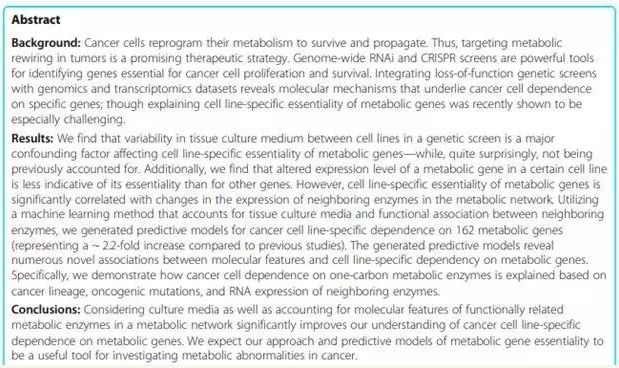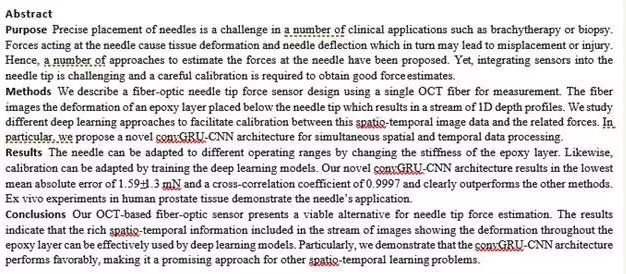SCI摘要部分的重要性仅次于SCI题目,绝大多数读者甚至审稿人阅读完题目以后,会先阅读文章的摘要部分,当摘要部分引起读者兴趣的时候,读者才会选择进一步地阅读其它部分。
别看摘要部分才短短的200-300字,但却麻雀虽小,五脏俱全,基本上是整篇文章的等比例的微缩版。摘要的写作难度并不大,有“起承转合”固定的写作模式,如果再结合我们所总结的几大板块以及相应部分的高频词汇词组,我想人人都可以成为摘要高手!
纵观各类期刊,摘要基本可以分为五大部分的内容:
第一部分:Background
第二部分:Purpose/Objective
第三部分:Methods (and Materials)
第四部分:Results/Findings
第五部分:Conclusions/Interpretation
很多期刊不会明确要求一定要按固定的模式写,就是写一段话,由作者决定安排这五部分的内容。但也有很多期刊,第一,四,和五部分是必选项,而对于第二部分和第三部分不同的杂志有各自不同的要求。
大家在投稿的时候要注意期刊对这五部分是怎么要求的,而且要看清要求的背景、研究目的、材料方法、结果、结论这几项英文单词的格式问题:有的只有首字母大写,有的要全部字母大写;有的要求这几个字母后面跟空格,有的跟冒号,有的要换行。
下面两个图是两个不同杂志的模板,大家可以看一下它们是怎样的要求。
BMC Biology

International Journal of Computer Assisted Radiology and Surgery

好了,说完了摘要写作基本的几个部分,我们开始每个部分的高频词汇词组总结,希望这22项不同类别的总结能给大家的摘要写作添砖加瓦:
第一部分:Background
1. 开头先提某研究方向很“重要”,“重要”的表示方法:
essential, profound impact, fundamental, major, have been intensively studied, have crucial (important) roles, powerful effects, has been a milestone, act as a primary XX, has attracted enormous interest in XX; has recently emerged as a key XX, one of the most common/prevalent/aggressive types of XX (affecting human health), show an important role in XX.
2. 某事很“严重”,所以要研究,“严重”的表示方法:
devastating, prevalent, severely affects, aberrant, abnormal, fatal, variable and unpredictable, rare and frequently aggressive.
3. 疾病的N种表示方法:
disease, disorder, dysfunction, aberrant.
4. 用数字说话,比例的修饰词汇总:
approximately (around) 5%, afflict up to 5% of the world's population, a total of.
第一部分和第二部分之间的连接/转折:
5. “未知”的各种表示方法:
(virtually) unknown, less is known, remains (largely) unknown, elusive, we know little about, unclear, still not well understood, poorly understood, there are few reports on.
6. 转折之后,观点所在,“转折”的表示方法:
but, however, nevertheless, yet, unlike conventional XX, while the results were conflicting and heterogeneous.
7. 如何“聚焦”到本篇文章,“聚焦”的表示方法:
Here, in this/current/the present study, toward this aim, in this work, our/the findings, our aim was to identify XX.
第二部分 Purpose/Objective
8. 研究的事物与其他事物比较/包含:
as compared with/to, consisting of.
9. 研究的主变量与某物相关:
involvement, be involved in; (highly) correlates/be related to, largely uncharacterized, be (closely/strongly/tightly) associated with, linked to, determine the relationship between A and B.
第三部分 Methods (and Materials)
10. 研究包括什么材料,应用了什么方法/处理/条件:
XX was used in/involved in XX; include; XX was treated with/genotyped by XX; Three treatments were applied, conducted, employed, performed, investigated, carried out.
第四部分:Results/Findings
11. 结果“展示”,“表明”, "证实"的表示方法:
postulate, found, show, demonstrate, indicate, suggest, provide direct (indirect)evidence, implicated, reveal, identify, validate, argue, investigate, explore, examined, report, discover, investigate, screen, uncover, detect, test.
12. 论述结果的执行动词:
measure, evaluate, provide an experimental strategy, map, review, observe, visualize, characterize, perform XX analysis, assess, retrieve from, download, select, construct, analyze, perform/ be carried out to, synthesized several sets of public data, preliminary clarify, build, obtain, download.
13. “结果”的多种表示方式:
these results, experimental and modeling data, the present study.
14. 论述结果的层级递进:
also, then, in addition (to), additionally, furthermore, moreover, subsequently, following, finally, (first, second, third), besides.
15. 借助于某某工具:
by means of, applied, use, via, in terms of, done, though, adopt quality criteria to classify the studies of XX analysis, based on, be according to.
16. “关键”结论的关键提示:
notably, be sufficient to, with a focus, intriguingly, interestingly, clearly, importantly.
17. 论述结果的其他高频副词:
respectively, precisely, accurately.
18. 两者之间一方对另一方施加影响,主变量“调控”因变量:
(bidirectionally 双向)(positively)(negatively) regulate, modulate, alter, promote, produce, elevate, reduce, activate, trigger, manipulate, enhance.
19. 主变量对因变量的影响:
lead to, cause, drive, be determined by, owing to, triggered by, resulting in.
第五部分:Conclusions/Interpretation
20. 总结词:
together, in summary, overall, thereby, therefore, collectively, in conclusion, taken together, in total.
21. 结论评价词:
simple, reliable, robust, largely consistent with, effective.
22. 科研要严谨,总结要慎重,下结论一般是各种“可能”:
might, may, possibly, it could be, would, can (“可能性”从左到右依次加强).
冰冻三尺,非一日之寒, 优登生物致力于帮助广大科研工作者解决学术写作和发表中的各方面问题,不但授人以鱼,亦授人以渔。如果您有相关疑问或建议,欢迎留言或私信我们交流讨论。